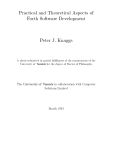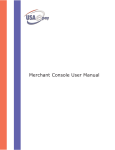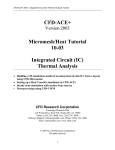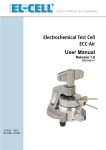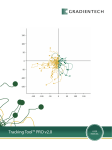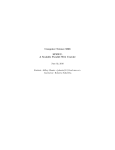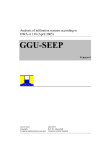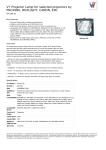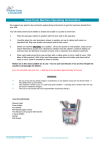Download MIX1D Users Manual Version 23d.1
Transcript
Metal Process Simulation Laboratory Department of Mechanical and Industrial Engineering University of Illinois at Urbana-Champaign Urbana, IL 61801 MIX1D Users Manual Version 23d.1 Brian G. Thomas Continuous Casting Consortium Report Submitted to Allegheny Ludlum AK Steel Columbus Stainless ISPAT Inland Steel LTV Stollberg, Inc. September 25, 2000 ******************************************************************** MIX1D User's Manual Version 23d.1 Brian G. Thomas University of Illinois at Urbana-Champaign Department of Mechanical and Industrial Engineering 1206 West Green Street, Urbana, IL 61801 Acknowledgments The MIX1D program was developed by Xiaoqing Huang at the Metals Process Simulation Laboratory at the University of Illinois under the direction of Professor Brian G. Thomas between 1991 and 1994. The project was sponsored by the Continuous Casting Consortium at UIUC, and the National Science Foundation (Grants MSS-8957195 and DMI9800274). Model calibration and validation wa made possible by experimental data and measurements on operating casters, which was provided by several different steel companies, notably including AK Steel (formerly Armco, Inc.), BHP, and Wierton. September 25, 2000. ******************************************************************** 2 Part I Introduction Welcome to MIX1D! MIX1D is a Fortran program which models intermixing during a grade change in the tundish and strand of a continuous caster. The model simulates one-dimensional transient solute transport-solidification that is coupled with an empirical mixing box model of the tundish and upper strand. It outputs the concentration history exiting the tundish, the composition distribution along the final slab length at different depths (eg. surface and center), and the final mixing length that does not satisfy the grade requirements for the two grades involved. The model is accurate (within the scope of available measurements), fast (runs on a PC in under 30 seconds, including graphical output), and includes a userfriendly interface which runs under Windows. It has been calibrated with both water modeling and caster experiments and is ready to be implemented on-line. 3 Part II How to run MIX1D (1) How to run MIX1D on IBM-PC (after copying all contents of floppy disk to a single folder on your PC hard drive) a) Copy sample input data file to 'xxxx.inp' (where xxxx is the common 4-character identifier you want to distinguish all of the files for this simulation). Edit this file to change the data as desired to match your conditions of interest (See Part III) b) Run mix1d by typing "mix1d" (from a DOS window) or double clicking on the mix1d.exe file c) Answer the questions asked interactively d) Examine output data contained in following output files: xxxx.out xxxx.dst xxxx.rcb xxxx.tun xxxx.cob xxxx.cct xxxx.csf xxxx.av1 xxxx.av2 (most important info summarizing .dst file and giving official mixing range) (summary of mixing range and locations for each element) (relative concentration profile along final slab length) (tundish composition – output if tundish is included in run, or input file if tundish data comes from elsewhere) (extra info for debugging purposes: intermediate results of tundish composition, intermediate results from strand backmixing-box model, intermediate results for strand: mesh,time marching, etc.) (slab / bloom centerline compositions) (slab / bloom surface compositions) (average composition along slab, based on surface and center) (average composition along slab, based on through-thickness profile) xxxx.min (minimum dimensionless concentration at lower boundary, used in plotting) xxxx.max (maximum dimensionless concentration at upper boundary, used in plotting) e) Extract data from these files and create graphics using your favorite Personal Computer or Macintosh graphics programs (eg. Kaleidograph or Excel) OR: Make plots in a window on your monitor by running the program wgnuplot and executing the 2 macro-routines provided by typing the following at the prompt in wgnuplot: Call 'g.tun' 'xxxx' 'yyyy' (compare relative composition histories exiting tundish from results of two runs xxxx.tun and yyyy.tun) Call 'g.rcb' 'xxxx' 'yyyy' (relative composition proifle along slab centerline and surface) After viewing each plot, type carriage return for next plot. 4 (2) How to run MIX1D on workstation a) Transfer files in sub directory src.unix to workstation (Warning: check last line to make sure the file transferred correctly) b) Type "make" to compile and get the executable file 'mix1d' on workstation c) Edit input data file and run MIX1D as in (1) a)-d) d) View data using the w gnuplot macros: plotg.tun, or plotg.rcb by typing at the unix prompt: plotg.tun xxxx yyyy or plotg.rcb xxxx yyyy Use ^C to get next plot. Alternatively, copy results files to another computer and postprocess with Kaleidograph or Excel etc.. 5 Model Description Details of the equations and fundamentals behind the model are provided in the attached papers. The model is based on matching the results of a 3D model of the mold [1]. Details of the model itself are provided in [1]. Finally, example applications using the model for a variety of tundish sizes and casting conditions are given in [3]. A description of the parameters in the input file follow. Do not insert or delete any lines except those beginning with >. For the first 3 sections of the program, lines beginning with > may be inserted or deleted as desired. Alloy element input (for each row): The first character in each line must be > (or * for last line) Second group of characters is the element name, (in quotes) Next three numbers are the actual measured amount of that element in the old grade, and minimum and maximum specification limits for that grade. The final 3 numbers apply to the new grade Time / casting speed data point input (for each row): Data point pairs are input to describe (roughly) the casting speed history both before and after the grade change. The data points are put together by the program to recreate the entire casting speed history using step-wise linear interpolation. The first character in each line must be > (or * for last line) The next numbers are the time (minutes), followed by the corresponding casting speed (meters/minute). The time values can be either actual clock times, or relative times (negative before and positive after) with respect to ladle open at time=0. In either case, the histories are related in the program to the time of ladle (first number in the next section) Time / tundish weight data point input (for each row): Arbitrary time and tundish weight histories are input in the same manner as casting speed. Only the tundish filling history is needed (drainage history before ladle open is not relevant) The first character in each line must be > (or * for last line) The next numbers are the time (minutes), followed by the corresponding tundish weight (tonnes). The data points are put together by the program to recreate the tundish filling history using stepwise parabolic interpolation. This avoids sudden changes in filling rate, which would upset the program stability. Arbitrary filling histories may be imposed simply by inserting more data points. Number of strands in operation Either 1 or 2 strand operation (the model also has been calibrated to work with 3 or 4 strands). The current tundish model calibration has been performed with respect to a single strand. 6 File name containing additional model parameters Model calibration parameters can be hidden in a second data file, if desired, simply by changing the ‘no’ input label in the first input file (eg. mix1.inp) to the name of the second input file (eg. mix1.con). Input values continue in the first (or second) file as follows: mold thickness (m), T, Change this value to model the appropriate mold shape: eg. billet, bloom, and slab casters. mold width (m), W, Input the strand width flying tundish change flag: The model has trouble modeling filling from an empty tundish, so if the tundish weight drops below about 2 tons, set this flag to 0, to model a sudden or “flying tundish change”, where the ladle and tundish are changed at the same time. (and composition entering the mold undergoes a step change from pure old grade to pure new grade at ladle open time) Otherwise, leave this flag set = -1. grade separator plate flag: A perfect grade separator is inserted at a specified distance below the meniscus (set on the next line). This prevents mixing in the strand below that point. However, mixing in the strand above is still possible. The model creates a growing box to simulate this condition. For ordinary grade changes, set this flag to 0 and the next line is ignored. official intermixing range flag: Choice of 5 criteria to define the extent of mixing, based on 1- satisfy 16 point average across bloom thickness 2- satisfy average of surface and centerline 3- satisfy both surface and centerline specifications 4-satisfy surface specifications only 5- satisfy centerline specifications only The model calculates intermixing lengths and cutting positions for each of these criteria, (providing output for every element, and for the worst case) given in file .dst The model also outputs the “official intermixing length and cutting positions, and the element responsible for the maximum length on the screen and in file .out. Note that the worst element may be different for the upper and lower cuts. maximum mixing simulation time for the tundish model (sec), tendbm: This time depends on the size of the strand, about 3000 s is needed for .4m thick blooms. Too small a number and the model will be unable to provide tundish exit concentration data sufficient to enable complete simulation of the strand. order number of 6 mixing boxes: These numbers may not be changed in the current version of the program number of time / data points for tundish volume fractions: 7 If this number is set to -1, then the program will automatically calculate the change in mixing box volumes during tundish filling in order to maintain a mass balance with incoming new grade. If this number is set =+1 or greater, then the user is expected to input the time history of the mixing box volumes. This allows the model to incorporate changes in mixing behavior during filling (such as short circuiting at small volumes) strand mixing box lengths: z0b1 and z0b2 These numbers model the 3-D mixing in the mold region as consecutive mixing boxes. They can be changed for changes in nozzle angle, etc., but must be first calibrated with the true 3-D model (which produced the values of 1.5m and 1.5m given for typical slab casting) Shell growth parameters: Shell thickness versus time is defined by 4 parameters. The first two cover initial shell growth: s = K1 t n 1 , s < f*T s = s2 + K2 t n 2 , s > f*T where K1, n1, n2, and f are user-specified parameters, chosen in the present to match break-out shell thickness measurements and finite difference solidification model calculations (to match the faster solidification rates found in the region of final solidification) K1 =.0032 m/s^5 n1 = 0.5 n2 = 7.0 f = 0.8 T = minimum bloom thickness (0.400m) where s2 and K2 are calculated by the model in order to maintain a continuous, smooth (continuous slope) curve between the two function regions: n1 s2 = fT (1 - n ) 2 n1 n1 K2 = n2 fT^(1 - n2 ) simulation start length, zstart (meters) The simulation starts at the given distance on the strand (below the meniscus at ladle open). This number is represented by its negative when reporting results later. total length of slabs / blooms simulated, slabl (meters) The simulation continues for the distance specified. Together with zstart, slabl determines the maximum extent of the mixing range expected. If zstart and slabl are too small, the model will report that the intermixing length is equal to this length and provide a warning message. Turbulence parameters: cd, tke0, tked0, cturb, dturb, cvc1, cvc2 Values for these parameters have been calibrated according to results from the 3-D model and only changed with care as part of re calibration. 8 Molecular diffusivity, deff0, (m2/s) This is the average laminar diffusion coefficient. It makes little difference to the program what real value is input here, as diffusion is governed by turbulent diffusion (ie. local convective transport in the liquid by the turbulent eddies). Liquid steel density, rho0, ρ (kg/m3) This density has been made larger than actual, so that the strand dimensions (solid) can be input as geometrically correct. The model does not include volume changes due to shrinkage or solidification Heat boundary offset, heatb (m) All model output is given with respect to either the heat boundary or the meniscus at ladle open, according to the flag in the last line of the input file. The value of this offset can be input directly (in m) or set to 0 to output all distances with respect to the position of the meniscus on the strand at ladle open. (In this case, the model output will change to indicate that output is with respect to ladle open. If the value of heatb is set to -1, the model will calculate the off set distance according to: heatb = tundish weight at ladle open / (number of strands * ρ * W * T ) Further explanations of the model input and output are provided when the program is run. 9 Calibrating the tundish mixing model: One method to calibrate the model is by generating tracer concentration vs. time profiles at the tundish outlet after die injection into water models (preferably “hot models”). Time=0 at the instant of die injection. The tracer data start from 0, stay at 0 during the plug flow time, increase to a max, and gradually decrease to 0. These tracer data can be integrated and normalized into continuous concentration versus time curves via (sigmoid-shaped curves increasing from 0 to 1) as follows: T(t) C(t+∆t) = C(t) + sum(T(t) from t=0 to t=infinity,4000s) where: T(t) = tracer concentration C(t) = continuous injection concentration t = time (0 = instant of tracer injection) These continuous concentration curves are output by mix1d, for comparison and calibration. The fraction of plug volume is calculated from: fplug = plug flow time or minimum residence time (s) theoretical mean residence time (s) tundish mass (kg) where: theoretical mean residence time = Vc (m/s) * T * W * ρ * (# of strands) Note that the number of strands was taken to be only 2, for either the 2 inner or 2 outer strands. The fraction dead volume is calculated from: actual mean residence time fdead = 1 - theoretical mean residence time sum ( T(t) * ∆t) where actual mean residence time = sum ( t * T(t) * ∆t) The mixed volume fraction is: fmix = 1 - fdead - fplug The values of the six mixing boxes should be changed until the model is able to generate the actual measured continuous concentraction curves. The above ideas are strictly guidelines to help generate these curves, as the tundish mixing model can be considered to be strictly empirical. 10 An example .out file is: =========================================================== | Mixing length is From old cut= -8.17 m | | 13.39 m (total) To new cut= 5.21 m | | | | Relative to transition point (meniscus at ladle open) | | | | A1_(%) is critical at old cut (dold) | | A1_(%) is critical at new cut (dnew) | =========================================================== Old cut New cut -----------|------------|-----------| | old grade | intermixed | new grade | | ------------------------------------z<0 z=0 z>0 (transition point) See .dst file for more info casting <------direction This file indicates where to cut the strand to isolate the intermixed slab to downgrade in order to meet the input specifications for each grade. The distances are all relative to the transition point, (which is the distance down the strand where the meniscus is found at ladle open for this example) 11 References 1. Huang, X., and B.G. Thomas, “Modelling of Steel Grade Transition in Continuous Slab Casting Processes”, Metallurgical Transactions B, Vol. 24B, No. 2 (April), 1993, pp. 379393. 2. Huang, X., and B.G. Thomas, “Intermixing Model of Continuous Casting During a Grade Transition”, Metallurgical Transactions B, Vol. 27B, No. 4 (August), 1996, pp. 617-632. 3. Thomas, B.G., “Modeling Study of Intermixing in Tundish and Strand during a Continuous Casting Grade Transition”, Iron and Steelmaker (ISS Transactions), Vol. 24, No. 12, Iron and Steel Society, Warrendale, PA, 1997, pp.83-96. 12















